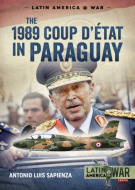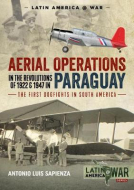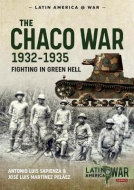
- Agriculture
- Architecture & Design
- Arts & Photography
- Biography
- Business
- Calendars and Diaries
- Childrens (All)
- Childrens (Illustrated)
- Childrens (Picture flats)
- Childrens (Te Reo)
- Classics
- Cooking, Food & Drink
- Craft & Hobbies
- Design (Art / Graphics)
- Design (Interiors)
- Education
- Fashion
- Fiction & Literature
- Fiction - Young Adult
- Gift Ideas
- Health & Wellbeing
- History
- Home & Garden
- Humour & Gift
- Instead of a Card Poems
- Military
- Music
- New Zealand
- NZ (History)
- NZ (Landscapes)
- NZ (Pictorial)
- Poetry
- Reference
- Religion & Faith
- Science & Nature
- Sport & Recreation
- Stationery
- Taschen : 40th Anniversary Edition
- Taschen : BA Basic Art
- Taschen : BU Bibliotheca Universalis
- Te Reo Māori
- Transport
- Travel
Antonio Luis Sapienza Fracchia (3)
|
The 1989 Coup DEtat in Paraguay (Latin America@War 11)
ISBN: 9781911628699 Author: Antonio Luis Sapienza Fracchia Publisher: Helion & Company The year 1989 was crucial for Paraguay. After a long period of 35 years of dictatorship, General Alfredo Stroessner was finally overthrown by a violent coup d�... The year 1989 was crucial for Paraguay. After a long period of 35 years of dictatorship, General Alfredo Stroessner was finally overthrown by a violent coup d’état. In a sort of prophetic way, he once said …”I came to power by arms and I will only leave by arms” and that came true on 2 February of that year. The 1989 Coup d’état in Paraguay discusses Stroessner’s climb to power during a coup of 1954, fraudulent elections that got him re-elected seven times, and the ways Stroessner kept himself afloat through cooperation with the armed forces, a right-wing political party, and the USA. Arguably, longing to maintain his popularity, the dictator launched a large number of major development projects, including construction of roads, water and sewage facilities, three big hydro-electrical power stations, and a build-up of an airline. At the same time, abuse of human rights and oppression of any kind of political opposition became a norm: dozens of political prisoners were tortured and even executed, and thousands driven into exile. As could be expected from a dictator with a military background, Stroessner prompted a major expansion and a build-up of the armed forces and the police, too. Nevertheless, it was the armed forces of Paraguay that brought about his demise: the coup that finally ended Stroessner’s rule was planned by General Andres Rodriguez, the Commander of the I Army Corps – and then with full support of large segments of the Army, Air Force and the Navy of Paraguay. A detailed description of the coup in question, and how Stroessner was driven into exile in Brazil, is the centrepiece of this narrative. Thirty years since the fall of Stroessner’s regime, many things have changed in Paraguay: still, many remain the same. Containing over 100 photographs, colour profiles, maps and extensive tables, ‘The 1989 Coup d’etat in Paraguay’ is a unique study and a source of reference about an important episode in Latin American history. Bind: paperback Pages: 64 Dimensions: 210 x 300 mm Publication Date: 15-02-2019 |
$49.99 |
|
|
Aerial Operations in the Revolutions of 1922 and 1947 in Paraguay (Latin America@War 8)
ISBN: 9781912390588 Author: Antonio Luis Sapienza Fracchia Publisher: Helion & Company In the first half of the 20th Century, there were several revolutions in Paraguay, starting in 1904, then 1908, 1911-12, 1922-23, 1936 and finally 1947. In 1922... In the first half of the 20th Century, there were several revolutions in Paraguay, starting in 1904, then 1908, 1911-12, 1922-23, 1936 and finally 1947. In 1922, a huge internal crisis in the Liberal Party led to a bloody revolution and for the first time in the history of the country, both sides decided to use aerial power against the enemy. There were not any airplanes available in Paraguay at that time, and very few pilots, just three, so both the government led by President Eusebio Ayala, and the revolutionaries led by a couple of Army colonels, Chirife and Mendoza, searched for foreign pilots and planes in Buenos Aires, Argentina. Many First World War veterans emigrated to Latin America in search of a better life, either opening flight schools or offering their services in local conflicts. That is how some of them came to Paraguay with their own aircraft, which were bought by either the government or the revolutionaries. The three Paraguayan pilots offered their services to the government, which soon established the first air base near the capital, in a wide open field called 'Ñu-Guazú' (a Guaraní name meaning 'Big Field'). Meanwhile, the rebels organized their own air base, first near the city of Villarrica, and later in Cangó. The main types used by both sides were the Ansaldo SVA5 and SVA10, but the government also managed to purchase a Breguet XIV, an Armstrong Whitworth FK.8, a SPAD S.20 and a couple of SAML A.3. Inevitably the first dogfights took place, and also bombing raids, strafing enemy troops, and recce missions on both sides. Finally, in mid-1923, the revolutionaries were defeated and one of the consequences was the foundation of the Military Aviation School. In contrast, the Revolution of 1947 lasted just a few months but it was as bloody as the previous one, if not more so. The government, supported by the Colorado Party, fought against the revolutionaries, composed of almost 70% of the Army, Navy and Air Arm, supported by the Liberal, Febrerista and Communist parties. Regarding the Air Arm, it split in two, but at the beginning most of the aircraft in flying conditions were used by the revolutionaries, whose main base was the city of Concepción, in the north of the country. Soon, the government air arm had some aircraft in flying condition although most of the Italian types purchased in 1939 were out of service. Only Lend-Lease trainers such as PT-19, BT-13, AT-6 types were used for recce and light bombing raids, using mortar ammunition. Some weeks later, the loyalists managed to repair some Caproni AP-1s to be flown against the rebels. There were a few dogfights but no aircraft were shot down in them, although some were lost due to AA fire. In the end, the government could defeat the revolutionaries, mainly because of the lack of tactical organization in the rebel forces. This is the first in-depth account of them with data, pictures, maps and profiles, some of them never published before. Bind: paperback Pages: 48 Dimensions: 210 x 297 mm Publication Date: 04-01-2019 |
$49.99 |
|
|
The Chaco War 1932-1935 (Latin America@War 20)
ISBN: 9781913118730 Authors: Antonio Luis Sapienza Fracchia, Jose Luis Martinez Pelaez Publisher: Helion & Company The Chaco War was the first modern conflict in South America. Over time, it became the topic of many volumes published in both Bolivia and Paraguay - first by v... The Chaco War was the first modern conflict in South America. Over time, it became the topic of many volumes published in both Bolivia and Paraguay - first by veterans, such as the commanders-in-chief, and the commanders of army corps', regiments or battalions, and by other ranks, in the form of personal memoirs or wider histories, and using a wide variety of sources. Subsequently, the conflict attracted attention of many foreign writers, foremost from the United States of America and Europe, who researched it with great interest. Hundreds of related articles have also been published. Nevertheless, The Chaco War, 1932-1935 is the first ever concise history of this conflict, providing the reader with the full background to this conflict, the military build-up of the Bolivian and Paraguayan armed forces, a blow-by-blow account of Bolivian penetration of this territory since the early 20th Century, precise details on troops mobilized for the war by both sides, all of the battles fought between the belligerents, and their casualties. Bind: paperback Pages: 72 Dimensions: 210 x 291 mm Publication Date: 30-09-2020 |
$49.99 |





